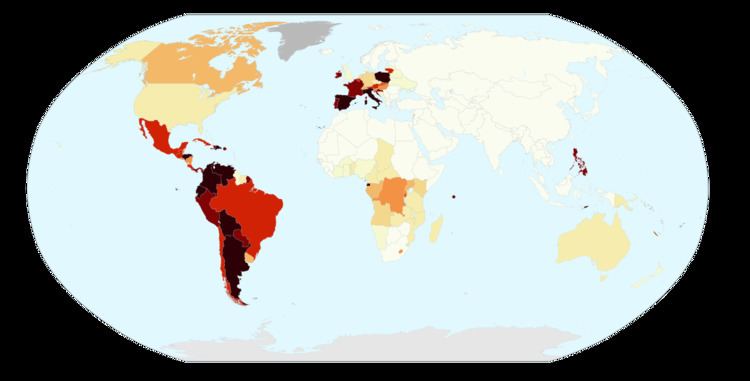 | ||
The Catholic Church in the Czech Republic is part of the worldwide Catholic Church, under the spiritual leadership of the Pope, curia in Rome, and the Conference of Czech of Bishops.
Contents
According to the 2011 census, there were 1.08 million Catholics in the country representing about 1/10 of the total population. There are eight dioceses including two archdiocese. In addition, there is a separate jurisdiction for those of the Byzantine Rite. Although the Catholic Church is the largest Christian religious grouping in the country, Czechs have historically been more loosely attached to the church for various reasons, especially the strong Hussite ethos and the staunch Catholicism of the oppressive Habsburg rule.
After the death of Jan Hus in 1415, the Czechs were mostly Hussite, a diverse sect which was considered heretical by the Catholic Church for some time but the majority of which made its peace with Rome quite soon. However, the Unity of the Brethren, founded in 1457, maintained a radical course and eventually played an important role in the Protestant Reformation and widely disseminating its principles. By the end of the 16th century, less than 20% of the population remained Catholic. After their defeat in the 1620 Battle of the White Mountain, Boheamia and Moravia were subjugated and forcefully re-converted to Catholicism by the imperial authorities, with Protestantism all but vanquished. The Czechs were solidly Catholic until after World War I, when anti-Catholicism fed by nationalist anti-German sentiment and national revival perceiving the Church as historical enemy caused mass defections from the Church. The reconstituted Protestant Hussite Church and the Czech Brethren were major beneficiaries of this defection from Catholicism until after World War II, when the Czechs largely abandoned them too; Protestants have proved receptive to atheism under Communist rule, with formerly Protestant East Germany and Estonia (see linked articles) also having irreligious majorities. In addition, the Sudeten Germans, who were those Austrians who ended up within Czech borders after World War I, were mostly Catholics, and their expulsion after World War II also reduced the Church's presence. Over 90% Catholic in 1910, the Czech Republic is now reduced to some 10%.
Communist regime
The Communist regime, which seized power in 1948 in what was then Czechoslovakia, confiscated all the property owned by churches and persecuted many priests. Churches were then allowed to function only under the state's strict control and supervision and priests' salaries paid by the state. Churches were seized, priests jailed or executed and those allowed to lead religious services did so under the supervision of the secret police. After the Velvet Revolution, some churches and monasteries were returned, but the churches have since sought to get back other assets such as farms, woodlands and buildings.
During the Communist regime, various underground Catholic movements existed. Among these is the Koinotes group, centered on Bishop Felix Davidek, whose vicar general was Ludmila Javorová, ordained by him to the presbyterate.
2012 Agreement
In January 2012 the Czech government agreed to pay billions of dollars in compensation for property seized by the former totalitarian regime to the Church. The compensation plan — to be spread over 30 years — proved a win-win situation: The state no longer wanted to pay the priests' salaries, and religious organizations expressed relief after previous failed attempts.
Under the plan, the country's 17 churches, including Catholic, Protestant and Orthodox, would get 56 percent of their former property now held by the state — estimated at 75 billion koruna ($3.7 billion) — and 59 billion koruna ($2.9 billion) in financial compensation paid to them over the next 30 years. Eighty percent of funds and property will go the Catholic Church, by far the biggest recipient.The state will also gradually stop covering their expenses over the next 17. In 2008, a similar bill was approved by the government but Parliament rejected it.
Structure
About 200 of the Czech Republic's 1,370 priests are from neighbouring Poland.
